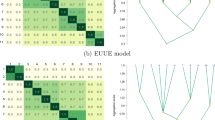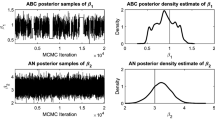Abstract
We consider the high-dimensional inference problem where the signal is a low-rank symmetric matrix which is corrupted by an additive Gaussian noise. Given a probabilistic model for the low-rank matrix, we compute the limit in the large dimension setting for the mutual information between the signal and the observations, as well as the matrix minimum mean squared error, while the rank of the signal remains constant. We also show that our model extends beyond the particular case of additive Gaussian noise and we prove an universality result connecting the community detection problem to our Gaussian framework. We unify and generalize a number of recent works on PCA, sparse PCA, submatrix localization or community detection by computing the information-theoretic limits for these problems in the high noise regime. In addition, we show that the posterior distribution of the signal given the observations is characterized by a parameter of the same dimension as the square of the rank of the signal (i.e. scalar in the case of rank one). This allows to locate precisely the information-theoretic thresholds for the above mentioned problems. Finally, we connect our work with the hard but detectable conjecture in statistical physics.


Similar content being viewed by others
References
Abbe, E., Sandon, C.: Detection in the stochastic block model with multiple clusters: proof of the achievability conjectures, acyclic BP, and the information-computation gap. Preprint (2015). arXiv:1512.09080
Aizenman, M., Sims, R., Starr, S.L.: Extended variational principle for the Sherrington–Kirkpatrick spin-glass model. Phys. Rev. B 68(21), 214403 (2003)
Baik, J., Arous, G.B., Péché, S.: Phase transition of the largest eigenvalue for nonnull complex sample covariance matrices. Ann. Probab. 33, 1643–1697 (2005)
Bandeira, A.S., Boumal, N., Singer, A.: Tightness of the maximum likelihood semidefinite relaxation for angular synchronization. Math. Program. 163, 1–23 (2016)
Banks, J., Moore, C., Vershynin, R., Verzelen, N., Xu, J.: Information-theoretic bounds and phase transitions in clustering, sparse PCA, and submatrix localization. In: 2017 IEEE International Symposium on Information Theory (ISIT), pp. 1137–1141. IEEE (2017)
Barbier, J., Dia, M., Macris, N., Krzakala, F., Lesieur, T., Zdeborová, L.: Mutual information for symmetric rank-one matrix estimation: a proof of the replica formula. In: Advances in Neural Information Processing Systems, pp. 424–432 (2016)
Benaych-Georges, F., Nadakuditi, R.R.: The eigenvalues and eigenvectors of finite, low rank perturbations of large random matrices. Adv. Math. 227(1), 494–521 (2011)
Boucheron, S., Lugosi, G., Massart, P.: Concentration Inequalities: A Nonasymptotic Theory of Independence. Oxford University Press, Oxford (2013)
Caltagirone, F., Lelarge, M., Miolane, L.: Recovering asymmetric communities in the stochastic block model. IEEE Trans. Netw. Sci. Eng. (2017). https://doi.org/10.1109/TNSE.2017.2758201
Chatterjee, S., et al.: A generalization of the lindeberg principle. Ann. Probab. 34(6), 2061–2076 (2006)
Coja-Oghlan, A., Krzakala, F., Perkins, W., Zdeborova, L.: Information-theoretic thresholds from the cavity method. Preprint (2016). arXiv:1611.00814
Decelle, A., Krzakala, F., Moore, C., Zdeborová, L.: Asymptotic analysis of the stochastic block model for modular networks and its algorithmic applications. Phys. Rev. E 84(6), 066106 (2011)
Deshpande, Y., Abbe, E., Montanari, A.: Asymptotic mutual information for the balanced binary stochastic block model. Inf. Inference: A J. IMA 6(2), 125–170 (2016)
Deshpande, Y., Montanari, A.: Information-theoretically optimal sparse PCA. In: 2014 IEEE International Symposium on Information Theory, pp. 2197–2201. IEEE (2014)
Féral, D., Péché, S.: The largest eigenvalue of rank one deformation of large wigner matrices. Commun. Math. Phys. 272(1), 185–228 (2007)
Ghirlanda, S., Guerra, F.: General properties of overlap probability distributions in disordered spin systems. Towards parisi ultrametricity. J. Phys. A: Math. Gen. 31(46), 9149 (1998)
Guerra, F.: Broken replica symmetry bounds in the mean field spin glass model. Commun. Math. Phys. 233(1), 1–12 (2003)
Guo, D., Shamai, S., Verdú, S.: Mutual information and minimum mean-square error in Gaussian channels. IEEE Trans. Inf. Theory 51(4), 1261–1282 (2005)
Hajek, B., Wu, Y., Xu, J.: Information limits for recovering a hidden community. In: 2016 IEEE International Symposium on Information Theory (ISIT), pp. 1894–1898. IEEE (2016)
Iba, Y.: The Nishimori line and Bayesian statistics. J. Phys. A: Math. Gen. 32(21), 3875 (1999)
Korada, S.B., Macris, N.: Exact solution of the gauge symmetric p-spin glass model on a complete graph. J. Stat. Phys. 136(2), 205–230 (2009)
Korada, S.B., Macris, N.: Tight bounds on the capacity of binary input random cdma systems. IEEE Trans. Inf. Theory 56(11), 5590–5613 (2010)
Korada, S.B., Montanari, A.: Applications of the lindeberg principle in communications and statistical learning. IEEE Trans. Inf. Theory 57(4), 2440–2450 (2011)
Krzakala, F., Xu, J., Zdeborová, L.: Mutual information in rank-one matrix estimation. In: Information Theory Workshop (ITW), 2016 IEEE, pp. 71–75. IEEE (2016)
Lesieur, T., Krzakala, F., Zdeborová, L.: MMSE of probabilistic low-rank matrix estimation: universality with respect to the output channel. In: 53rd Annual Allerton Conference on Communication, Control, and Computing, Allerton 2015, Allerton Park and Retreat Center, Monticello, IL, USA, September 29–October 2, 2015, pp. 680–687 (2015)
Lesieur, T., Krzakala, F., Zdeborová, L.: Phase transitions in sparse PCA. In: IEEE International Symposium on Information Theory, ISIT 2015, Hong Kong, China, June 14–19, 2015, pp. 1635–1639. IEEE (2015)
Méasson, C., Montanari, A., Richardson, T.J., Urbanke, R.: The generalized area theorem and some of its consequences. IEEE Trans. Inf. Theory 55(11), 4793–4821 (2009)
Mézard, M., Parisi, G., Virasoro, M.: Spin Glass Theory and Beyond: An Introduction to the Replica Method and Its Applications, vol. 9. World Scientific, Singapore (1987)
Milgrom, P., Segal, I.: Envelope theorems for arbitrary choice sets. Econometrica 70(2), 583–601 (2002)
Montanari, A.: Estimating random variables from random sparse observations. Eur. Trans. Telecommun. 19(4), 385–403 (2008)
Montanari, A.: Finding one community in a sparse graph. J. Stat. Phys. 161(2), 273–299 (2015)
Neeman, J., Netrapalli, P.: Non-reconstructability in the stochastic block model. Preprint (2014). arXiv:1404.6304
Nishimori, H.: Statistical Physics of Spin Glasses and Information Processing: An Introduction, vol. 111. Clarendon Press, Oxford (2001)
Panchenko, D.: The Sherrington–Kirkpatrick Model. Springer Science & Business Media, Berlin (2013)
Perry, A., Wein, A.S., Bandeira, A.S., Moitra, A.: Optimality and sub-optimality of PCA for spiked random matrices and synchronization. Preprint (2016). arXiv:1609.05573
Rangan, S., Fletcher, A.K.: Iterative estimation of constrained rank-one matrices in noise. In: 2012 IEEE International Symposium on Information Theory Proceedings (ISIT), pp. 1246–1250. IEEE (2012)
Saade, A., Lelarge, M., Krzakala, F., Zdeborová, L.: Spectral detection in the censored block model. In: 2015 IEEE International Symposium on Information Theory (ISIT), pp. 1184–1188. IEEE (2015)
Saade, A., Lelarge, M., Krzakala, F., Zdeborová, L.: Clustering from sparse pairwise measurements. In: 2016 IEEE International Symposium on Information Theory (ISIT), pp. 780–784. IEEE (2016)
Talagrand, M.: Mean Field Models for Spin Glasses: Volume I: Basic Examples, vol. 54. Springer Science & Business Media, Berlin (2010)
Talagrand, M.: Mean Field Models for Spin Glasses: Volume II: Advanced Replica-Symmetry and Low Temperature, vol. 55. Springer Science & Business Media, Berlin (2011)
Wu, Y., Verdú, S.: Functional properties of minimum mean-square error and mutual information. IEEE Trans. Inf. Theory 58(3), 1289–1301 (2012)
Zdeborová, L., Krzakala, F.: Statistical physics of inference: thresholds and algorithms. Adv. Phys. 65(5), 453–552 (2016)
Author information
Authors and Affiliations
Corresponding author
Rights and permissions
About this article
Cite this article
Lelarge, M., Miolane, L. Fundamental limits of symmetric low-rank matrix estimation. Probab. Theory Relat. Fields 173, 859–929 (2019). https://doi.org/10.1007/s00440-018-0845-x
Received:
Revised:
Published:
Issue Date:
DOI: https://doi.org/10.1007/s00440-018-0845-x




